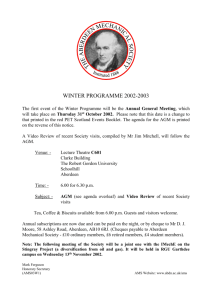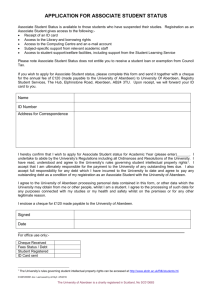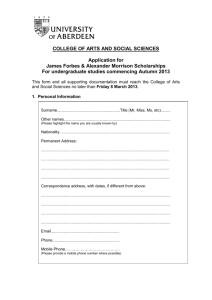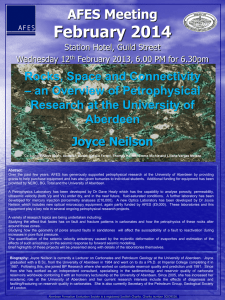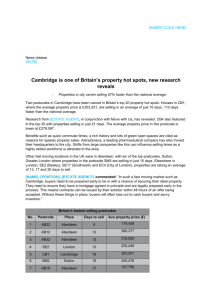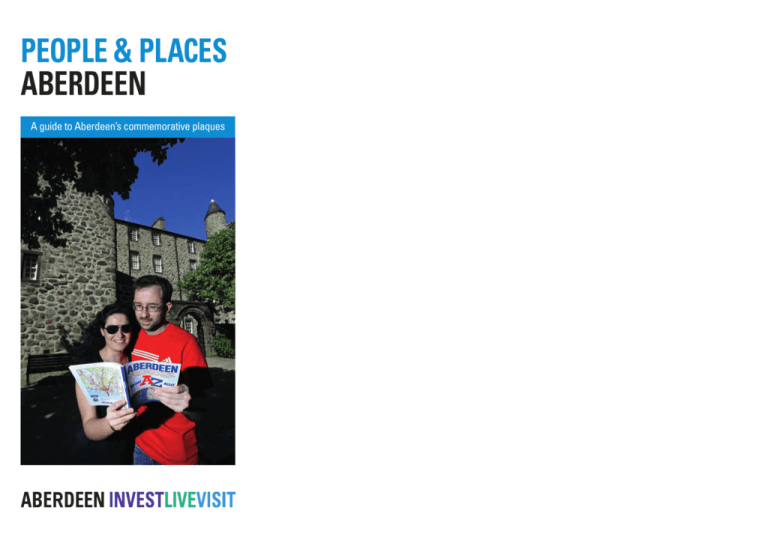
PEOPLE & PLACES
ABERDEEN
A guide to Aberdeen’s commemorative plaques
Aberdeen’s Heritage Trail Leaflets
Granite Trail
March Stones Trail
Maritime Trail
North Sea Trail
Old Aberdeen Trail
Sculpture Trail
INTRODUCTION
Plaques exist in a variety of different guises and in many different
locations in and around Aberdeen City. They commemorate people and
places that have shaped Aberdeen; people who have made outstanding
achievements in their field; and streets, buildings or events of particular
historical prominence.
From the nineteenth century plaques have been erected in Aberdeen often
through the auspices of individuals or societies. These plaques are
described as ‘non-standard’. In the 1970’s, the City Council introduced a
degree of regularity, standardising most plaques erected to commemorate
people as a distinctive round plaque design, whilst court plaques
commemorating streets of historical importance are rectangular with a
domed top edge.
This leaflet draws attention to a number of plaques in the city centre and
Old Aberdeen. A list appended at the end of this leaflet provides basic
information on other plaques in alphabetic order.
The plaque numbers on the City Centre map indicate a suggested walking
trail. Most surfaces along this route are generally level. Following the
suggested route will require crossing busy roads and it is the
responsibility of members of the public to ensure their personal safety.
We recommend the use of pedestrian crossing points where available.
Most plaques are visible from public areas, but please be aware that
some are located on private property.
Aberdeen City Council is always pleased to accept sponsored nominations
for new plaques. Guidelines for this process and information on all of our
other plaques can be found at www.aberdeencity.gov.uk/plaques
All plaques are accessible for people with disabilities unless indicated by
the symbols below.
Picture Credits
Cover Provost Skene’s House
This page Thomson’s House, Archway
No.7 ‘Titian Preparing to Make his First Essay in Colouring’, by William Dyce, 1856-7,
Aberdeen Art Gallery and Museums Collections
No.18 Photograph by George Washington Wilson,
Aberdeen Library and Information Services
No.26 George Jamesone, self portrait, 1637,
Aberdeen Art Gallery and Museums Collections
No.33 Portrait of Thomas Reid, date and artist unknown, after Raeburn,
University of Aberdeen
No.35 Portrait of Patrick Manson, date and artist unknown,
London School of Hygiene and Tropical Medicine
No.37 ‘The Bridge of Don’, by William Daniell, date unknown,
Aberdeen Art Gallery and Museums Collections
Accessible from street indicated
Accessible via ramp or steep slope
Not wheelchair accessible
Plaque Styles
Round Plaque
Non Standard Plaque
Court Plaque
Stone Tablet
EP
STE
1
John Forbes White 1831-1904
6
Flour Merchant and Patron of the Arts
60 Frederick Street
Educated at Aberdeen Grammar School and Marischal
College, he became an innovative flour miller and corn
merchant. He held the Directorship of the North of Scotland
Bank and Aberdeen Jute Company, became President of the
British and Irish Association of Millers in 1888 and was ViceConsul for Sweden and Norway. White was awarded an
honorary LLD from Aberdeen University in 1886. He is also
remembered as a pioneer amateur photographer and sponsor
of Aberdeen Art Gallery. He was also an influential writer on
art, a collector of innovative contemporary art and patron to
many young artists whose career flourished as a result.
2
Catholic bishops
Chapel Court off Castle St (Castlegate)
Grant was the fourth Catholic priest in Aberdeen following
the Reformation. By the 1770s, his growing congregation
needed a permanent place of worship. A site near the
Justice Port in the Castlegate was bought in 1771, upon
which a chapel and house was erected. Geddes, one time
rector of Scalan College, was instrumental, along with Priest
Gordon, in arranging the erection of St Peter’s Chapel.
Geddes was uncle to Priest Gordon.
3
Lawyer and Historian
46 Marischal Street
Born in Aberdeen, he
practised as a lawyer in the
city. He is best known as a
local historian who
compiled a three-volume
alphabetical index to the
council registers of Aberdeen
City Council from 1398-1836. He
is principally remembered as
author of the two-volume
Annals of Aberdeen.
7
Bishops Grant and Geddes
William Kennedy 1758-1836
William Dyce 1806-1864
EP
STE
EP
STE
Artist
48 Marischal Street
Educated at Aberdeen Grammar School and Marischal
College, he worked with oil and watercolour, in fresco, and
designed stained glass. His finest easel pictures are of
religious subjects. He was elected an Associate of the Royal
Scottish Academy in 1835. He is remembered as a leader of
the High Church Movement and as a chorister and composer.
Mother St Basil 1827-1878
Mother Superior of the Poor Sisters of Nazareth
Chapel Court off Castle St (Castlegate)
During the first year of their existence, Victoire Larmenier
(later Mother St Basil) became Mother Superior of what we
know as the Congregation of the Poor Sisters of Nazareth.
The order provides care for the elderly and poor. The
Aberdeen foundation was the second of the order. Between
1862 and 1872 they occupied the presbytery of St Peter’s
Chapel, which at that time was not in use.
4
John Barbour 1316-1395
Poet and Author
53 Castle Street
In 1357 he became the Archdeacon at St Machar’s Cathedral,
Aberdeen, and travelled frequently to Oxford to study. He
was the author of the metrical The Brus, a life of Robert the
Bruce and the now lost A Chronicle of Scottish History.
5
George Thomson 1804-1895
EP
STE
Clipper Ship Owner
35 Marischal Street
Born in Woolwich and educated at Aberdeen Grammar
School, he developed his own business as a Ship Insurance
Broker in 1825. He became principal owner of the world
famous shipping line, ‘The Aberdeen White Star Line’, which
included the fast tea clipper the ‘Thermopylae’. He was
elected Dean of Guild in 1840 and Lord Provost of Aberdeen
in 1847.
'Titian Preparing to Make his First Essay in Colouring', by William Dyce
8
Exchequer Row
13 Samuel Seabury 1729-1796
Exchequer Row
This commemorates the site of the Royal Exchequer and
possibly Aberdeen’s mint, which functioned intermittently in
Aberdeen from the reign of David I (1124-1153) to James III
(1460-1488). Coins issued in Aberdeen bore the name of the
mint, ‘Villa Aberdon’.
9
Catherine Hollingworth 1904-1999
Speech Therapist and Child Drama Pioneer
31 King Street
Born in Brechin and educated at the Royal Academy of
Music, she became Aberdeen’s first teacher of speech in
1941. In 1942 she created the Aberdeen Children’s Theatre
which attracted international recognition for its pioneering
work in the field of child drama.
10 Concert Court
off Broad Street
This commemorates the site of a nearby hall in which the
city’s first organised concerts were held. They were
organised by Francis Peacock, dancing master, and Andrew
Tait, organist, who had founded the Aberdeen Musical
Society in 1748. In 1749, the Society leased a house, the ‘New
Music Room’ in adjacent Huxter Row. The Society came to
an end in 1806.
11 Alexander Cruden 1699-1770
FROM
QUEEN ST
Compiler of the First Concordance
to the Bible
Cruden’s Court, off Concert Court, Broad Street
Born in Aberdeen and educated at Marischal College, he
worked in London as a bookseller to Queen Caroline and
completed his concordance in 1737. He became known as the
self-styled ‘Alexander the Corrector’, believing himself to be
commissioned from heaven to reform the morals of the nation
and put himself forward as a candidate for the General
Election in 1754.
12 Guestrow
off Broad Street
This intriguing name,
which is unique to
Aberdeen, is a little
obscure in its origins.
One of the main
suggestions is that it
refers to the street of the
spirits or ghosts, and
that it was originally
given in a form like
‘Ghaistraw’.
Episcopalian Bishop
Marischal College, Quadrangle, Broad Street
Born in Connecticut and educated at Yale College,
Newhaven, he was later created Episcopalian Rector in New
York. After American Independence he was elected the first
Episcopalian Bishop in America and consecrated in 1784 by
Bishops Kilgour and Skinner in Aberdeen.
14 Sir Alexander Robertson 1908-1990
Veterinary Surgeon
Marischal College, Quadrangle,
Broad Street
Born in Aberdeen and educated at
Marischal College, he became
Director of the Royal School of
Veterinary Surgeons and Dean of
the Faculty of Veterinary Medicine
and Professor of Tropical Animal
Health at Edinburgh. In 1954, he was
elected President of the British Veterinary
Association.
15 Kirkgate Court
Upperkirkgate
John Farquhar and David Gill, Painters and Glaziers, bought
adjacent land in 1828. Farquhar and Gill Colour Works
operated until 1972. Kirkgate Court is also known as
Farquhar’s or Painter’s Court.
16 Drum’s Lane
Upperkirkgate
This commemorates the
location of Lady Drum’s
Hospital. In 1633 Marion
Douglas, Lady Drum, mortified
the sum of 3,000 merks for a
commodious house for poor
widows and aged virgins.
Building began in 1671.
By 1721, the house also
accommodated daughters of
Burgesses of Guild. In 1798
the area was redeveloped and
Drum’s Lane was laid out.
17 Flour Mill Lane
Flour Mill Lane
This commemorates the site of the Royal Burgh of Aberdeen’s
Upper Mill. The mill, fed by the mill burn, stood nearby from
the thirteenth century until 1865. The mill not only provided
wheat, rye and malt for the burgh but also revenue through
the lease.
18 Thomson’s House,
Archway
22 James Clerk Maxwell 1831-1879
Provost Skene’s House,
Guestrow, off Broad Street
This commemorates an archway
and date stone from a
seventeenth-century house. The
archway was erected in 1637 by
Andrew Thomson, Advocate and
Sheriff-Depute in Aberdeen, as the
gateway to his house in Guestrow.
His initials and those of his wife,
Agnes Divie, are on the panel built
into this wall. On demolition of the
properties in Guestrow, in 1931, the archway was rebuilt in
Union Terrace Gardens, from where it was taken in 1970 and
re-erected here.
19 Benholm’s Lodge 1600-Present
Netherkirkgate
Also known as the Wallace Tower, Benholm’s Lodge, a
fortified tower, was built on this site about the year 1600. In
1965, through the generosity of
Lord Marks, the corporation
were enabled to remove the
building and re-erect it in its
original form on a site at
Tillydrone Road, Old Aberdeen,
where it is preserved for
posterity.
20 Adelphi Court
off Union Street
This is named after the
Adelphi in London, located off
The Strand. The London Adelphi
was laid out by the brothers
John and Robert Adam and the
name commemorates this
relationship: Adelphi is Greek
for ‘brothers’.
Benholm’s Lodge The street was laid out on the
crest of St Katherine’s Hill in the
early nineteenth century. Other Aberdeen streets named after
London streets are: Whitehall; Spring Garden and Mile End.
21 John Smith 1781-1852
Architect
Kirk of St. Nicholas Colonnade, Union Street
He trained in Aberdeen and London becoming
Superintendent of Works (the office of which later became
City Architect) in 1807. He designed St Nicholas Church
frontage colonnade and buildings in King Street, often
working as both rival to, and in collaboration with,
Archibald Simpson.
Natural Philosopher
131 Union Street, Back Wynd Steps
Born in Glenlair, Galloway and educated at Edinburgh
Academy and Edinburgh and Cambridge Universities, he
contributed to the analysis of colour perception. He became
the first person to print a colour photograph, but he is best
known for his work on electricity and magnetism. Maxwell
served as Professor of Natural Philosophy at Marischal
College and London University.
23 Correction Wynd
FROM
ST NICHOLAS ST
Back Wynd, off Union Street
This commemorates the location of the House of Correction
which was founded on the initiative of Provost Jaffray in 1637
and stood nearby until 1711. It provided vagrants and
delinquents with lodgings and employment in the cloth
industry.
24 Edward Raban 1579-1658
FROM
UNION ST
Printer
Kirk of St. Nicholas, East Wall of kirkyard
He set up Aberdeen’s first printing press in the Castlegate in
1622. He produced Scotland’s first book of fully harmonised
psalms and the Aberdeen Almanac, as well as printing over
250 works between 1622-1649.
25 James Gibbs 1682-1754
FROM
UNION ST
Architect
West Kirk of St. Nicholas, Union Street, West Wall
Born in Footdee, Aberdeen, he studied in Italy and his
Book of Architecture helped to spread the Palladian style
throughout the New World. A friend and disciple of Sir
Christopher Wren, in 1713, Gibbs became one of the
commissioners for building new churches in London.
He went on to design St. Martin-in-the-Fields (1726),
St. Bartholomew’s
Hospital (1730), The
Senate House for
Cambridge University
(1730), The Radcliffe
Camera for Oxford
University (1737-47) and
West Kirk of St. Nicholas
in Aberdeen
(constructed 1752-55).
He was made a Burgess
of Aberdeen in 1739.
26 George Jamesone
1588-1644
Portrait painter
22 Schoolhill
There are two plaques at
this location. Born in
Aberdeen, it is believed
George Jamesone
that he studied with Rubens in Antwerp. He was Scotland’s
first indigenous portrait painter of any note and was
commissioned to paint a portrait of Charles I at his
coronation in 1633.
27 James Leatham 1865-1945
Socialist, politician and propagandist
68 Schoolhill
Born in Aberdeen, Leatham was
apprenticed to a firm of printers
and then established his own
printing shop in 1889. A militant
advocate of free speech, he
published The Workers’ Herald,
Scotland’s first socialist newspaper
and became editor of The Peterhead
Sentinel in 1897. Leatham served as
Provost of Turriff 1933-1945.
Composer
16 Elmbank Road
Born in Aberdeen, he served as
Organist at High Hilton Church and
taught at The Gordon Schools,
Huntly. He is remembered as a
composer of string quartets and
piano works, Lachrymae for string
orchestra and the cantata Dona
Nobis Pacem.
32 Helena Mennie Shire 1912-1991
28 Mary Slessor 1848-1915
Missionary
Nandos, Former United Presbyterian Church (now part of
Academy Shopping Centre) Belmont Street
Born in Aberdeen, she was the daughter of a cobbler. She
entered employment in Dundee’s Jute Mills. She sailed
with the Foreign Missions Board to the Calabar Estuary
(now South Nigeria), aged 26, and worked in the capital,
Duke Town, and in the Okoyoung District.
29 Alexander Gordon 1752-1799
Obstetrician
17 Belmont Street
Born in Peterculter, he gained his MA at Marischal College
before reading medicine at Aberdeen Infirmary, Edinburgh
and Leiden. He worked as a surgeon in HM Navy prior to
studying midwifery in London. Gordon was appointed
physician to the Aberdeen Dispensary in 1785 and
published A Treatise on the Epidemic Puerperal Fever of
Aberdeen, 1795.
30 Sir John Ninian Comper 1864-1960
31 Ronald Center 1913-1973
NO LEVEL
ACCESS
Church Architect
17 Spital, St Margaret’s Convent
Born in Aberdeen, the son of an Episcopalian clergyman, he
was educated at Trinity College, Glenalmond. He studied art
at Edinburgh, Oxford and the Royal College of
Art London, and was apprenticed to an
Ecclesiastical Architect’s Practice in
1887. He designed the chapel of the
Convent of St Margaret of Scotland,
Spital in 1891 and the Seabury
Memorial Restoration,
St Andrew’s Cathedral.
Scholar of the Literature and Music
of Scotland
98 Leslie Terrace
Born in Aberdeen and educated at
Aberdeen and Cambridge Universities,
she taught in the English faculty at
Cambridge where she researched
medieval and renaissance music and
literature. She was appointed Emeritus
Fellow of Robinson College, Cambridge in 1980.
33 Thomas Reid 1710-1796
Enlightenment scholar and philosopher
Pend of King’s College Quadrangle, High Street,
Old Aberdeen
Reid studied at
Marischal College,
where he was later
librarian. He was to
found the school of
‘common sense’
philosophy and was
a great contributor to
the Scottish
Enlightenment of the
eighteenth century.
He later taught at
King’s College.
34 William
MacGillivary
1796-1852
Ornithologist
110 High Street,
Old Aberdeen
Thomas Reid
Born in Old
Aberdeen, he was educated at King’s and Marischal Colleges
and appointed Regius Professor of Natural History at
Aberdeen in 1841. His five volume History of British Birds,
along with his work with American bird artist James John
Audubon laid the foundations of modern ornithology. His
observations about birdlife were also used by Charles Darwin
for his work on The Descent of Man.
35 Sir Patrick Manson
1844-1922
City Centre Trail
Pioneer of medical science
Cruickshank Building,
Old Aberdeen
Born in Oldmeldrum, he
attended school in the Gym
(Chanonry House) School in
Old Aberdeen. He later
graduated from Aberdeen
University as MD in 1866.
He was the first person to
recognise that insects carry
Sir Patrick Manson
diseases and he set up what
would become Hong Kong University’s Medical School as
well as being instrumental in founding the London School of
Tropical Medicine.
36 Francis Masson 1741-1805
Botanist and explorer
Cruickshank Botanical Gardens, Old Aberdeen
Born in Old Aberdeen, he obtained an appointment at Kew
Gardens and travelled the world collecting botanical
specimens. He published Stapelliae Novae in 1796 and died
in Montreal.
37 Brig o’ Balgownie c.1280-Present
Industrialist and entrepreneur in Japan
Glover House, Balgownie Road
Born in Fraserburgh and educated
at the Chanonry School, Old
Aberdeen, he travelled to Japan in
1859 and later imported the first
steam locomotive. He helped to
establish the Mitsubishi Nagasaki
Shipyard and received the Order of
the Rising Sun from the Emperor
in 1908.
Bon Accord
and St Nicholas
Centre
EP
STE
Brig o’ Balgownie
This plaque
provides
information about
this venerable
structure which
was scheduled as
an Ancient
Monument in 1971.
The bridge that
stands today was
the result of
rebuilding the older
Brig o’ Balgownie
bridge in three
stages between 1607 and 1611. It is unknown exactly when
the original bridge was built, but local legend suggests that it
dates from either the later thirteenth or early fourteenth
century.
38 Thomas Blake Glover 1838-1911
Bon Accord
and St Nicholas
Centre
Union
Square
Old Aberdeen Area Trail
Other Plaques in Aberdeen
Round Plaques
William Alexander, 3 Belvidere Street
Dugald Baird, 38 Albyn Place
May Baird, 38 Albyn Place
John Boyd Orr, Director’s Residence, Rowett Institute, Greenburn Road
David Smith Cairns, Former Christ’s College, Alford Place
James Cowie, 8 Fonthill Road
Alexander Ellis, 66 Springbank Terrace
Mary Esslemont, 30 Beechgrove Terrace
Elizabeth Latto Ewen, 26 Chapel Street
Ian Fleming, 15 Fonthill Road
George Milne Fraser, Central Library, Rosemount Viaduct
Mary Garden, 41 Dee Street
James William Giles, 64 Bon Accord Street
David Gill, 48 Skene Terrace
Lewis Grassic Gibbon, 5 St Mary’s Place
William Jackson, Thorngrove, 500 Great Western Road
Robert Laws, 39 Thistle Street
John James Rickard McLeod, 32 Cairn Road, Cults
James Matthews, 15 Albyn Terrace
Hugh Mercer, Marischal College Quadrangle, Broad Street
Francis Peacock, Peacock’s Close, Castle Street
William Penny, 1 South Crown Street
George Reid, Gordon Highlanders’ Museum, Viewfield Road
Jeannie Robertson, 90 Hilton Road
Thomas Scott Sutherland, 27 Albyn Place
Robert Sivell, 51 Whitehall Road
Lilias Gillespie Skene, Religious Society of Friends’ Meeting House,
Crown Street
William Robertson Smith, Former Christ’s College, Alford Place
Rachel Annand Taylor, Harlaw Academy, 18-20 Albyn Place
George Paget Thomson, Marischal College Quadrangle, Broad Street
James Cromar Watt, 71 Dee Street
George Washington Wilson, 1 Queen’s Cross
James Fenton Wyness, 45 Salisbury Terrace
Non Standard Plaques
John Abercrombie, Abercrombie Jetty
Alexander Anderson, North Pier (Not Accessible To The Public)
Bannerman’s Bridge, Marischal Street
The Blockhouse, Pocra Quay
Carmelite Friary, Car Park off Rennie’s Wynd
James Chalmers, Aberdeen Journals Building, Lang Stracht
Crabstane, Langstane Place
George Davidsone, St Clement’s Church, St Clement Street
Mary Garden, Craigie Loanings
Grammar School, Robert Gordon’s College, Schoolhill
David Grant, St Clement’s Church, St Clement Street
Hardgate Well, Hardgate
John Phillip, 21 Skene Square
Provost Ross’ House, Aberdeen Maritime Museum, Shiprow
Archibald Simpson, Bon Accord Square
Templar Religious House, Rear wall of exterior of St Peter’s Churchyard
Court Plaques
Brebner’s Court, Castle Street
Fittie Wynd, Castle Street
Poultry Market Lane, West wall of Aberdeen Arts Centre, King Street
PEOPLE & PLACES
ABERDEEN
one of a series of themed trails
being developed around the City.
77
B9
Aberdeen
Airport
A96
A90
Further details about these trails can be found at:
www.aberdeencity.gov.uk/heritagetrails
Dyce
River
Don
Bridge
of Don
9
97
B
Kingswells
People & Places
Trail Area
B984
0
A9
ABERDEEN
4
Westhill
A94
Torry
Cults
A9
56
Doonies Farm
Cove Bay
A9
Peterculter
ee
er D
Riv
Charlestown
0
A93
4 Miles
© Crown copyright. All rights reserved. Aberdeen City Council – 100023401 – 2013
For further information contact
Chris Croly, Historian
01224 337706
or visit www.aberdeencity.gov.uk
Aberdeen Visitor Information Centre.
Contact 01224 288828
www.aberdeen-grampian.com
For public transport information contact Travel Line
on 0871 200 22 33
or visit www.travelinescotland.com
For a large text version contact
01224 337706
www.aberdeeninvestlivevisit.co.uk
@aberdeenilv




